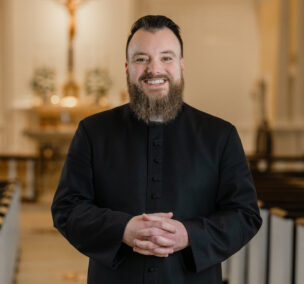Dear Brothers and Sisters in Christ,
With the resumption of public Masses come certain requirements that at first glance may feel or seem jarring to our normal experience. Some are easy to understand – for example, wearing masks, maintaining safe social distance, and not shaking hands – while some require further explanation. What follows is a brief explanation of just a few of those liturgical norms we are following in the Diocese of Bridgeport.
The Processions
Ordinarily, the priest and servers process through the center aisle of the church as they approach or exit the sanctuary. The procession is a symbol of the “journey” of the whole people of God who seek the heavenly kingdom. It hearkens back to Moses leading the Israelites to the foot of Mt. Sinai (cf. Exodus 19:16-17), where he then went up the mountain to receive the Ten Commandments. Men of a certain age will remember serving at Mass and praying, at the foot of the altar, the words of Psalm 43 “I will go up to the altar of God, the God who gives joy to my youth.” In our coronavirus-modified circumstances, the procession is abbreviated, coming from the sacristy directly to the sanctuary, and includes only the priest. The symbolism is the same – the whole Christian people, united in faith, is going to the holy place where the priest will pray both with them, and on their behalf. According to the guidelines for worship the Diocese of Bridgeport has in force right now, the priest is not permitted to greet people at the door of the church after Mass. We don’t like it, either.
The music and singing
Due to concerns about spreading aerosolized particles by singing, many different organizations have recommended omitting congregational singing. The Diocese of Bridgeport’s liturgical directives ask the congregation to refrain from singing. If this is so, then why have music at Mass at all?
Music, specifically chanted prayer, has been part of the Church’s liturgical practice from time immemorial. While it is not always strictly required, the intention and vision for the celebration of Mass involves at least some singing. Much of that singing, though, is meant to be done by the celebrant. Certain parts may be chanted by a cantor or choir, or by the congregation. When it is not possible for a choir or congregation to chant those parts, the ministry of cantor is important. The cantor sings, not to act as a soloist, but to pray on behalf of the entire congregation. For its part, the congregation listens and prays along interiorly. In this time when we must remain silent, let us appreciate the ministry provided by cantors and musicians in our worship.
The choice of music is an interesting topic. At your average American parish, hymns are the norm for music at the entrance, at the offertory, at communion, and at the end of Mass. It is interesting to note, however, that of all the options listed in the rubrics for the Mass, hymns (or as they are called in the General Instruction of the Roman Missal, “suitable chants”) are the last choice given. Prior to some other suitable chant, the General Instruction lists three different sources for an antiphon and psalm which would be sung at the Entrance, Offertory, and Communion. For some reason, in the last several decades, we have been fed a steady musical diet of fourth-choice!
Antiphons are simple verses from Scripture that, in the context of the Mass, echo the Scripture readings and connect them to the Psalms, the ancient prayers of Israel that Jesus Himself would have prayed. Antiphons have been used in the liturgy of the Church for centuries upon centuries. The Responsorial Psalm (more on this below) is the form of antiphonal prayer most familiar to us today. Why have antiphons so largely disappeared from use in American parishes? In part, it is simply a question of neglecting the General Instruction of the Roman Missal. In part, publishing companies promoting hymnals for use in parishes have omitted antiphons (Big Hymnody is not quite as challenging as Big Pharma or Big Tobacco, but it’s still Big).
You have heard antiphons here at St. Pius X, especially during Communion, for the last few years. They provide a simple, elegant, Scriptural chant. They also help us to follow the very simple directions given by the Church to help us worship. During a time when congregational singing is not possible, they provide a simple way to add music that can easily be sung by one voice and can be easily understood by all who listen prayerfully.
The Responsorial Psalm
Ordinarily the Psalm in the Liturgy of the Word includes an antiphon sung by the congregation between the verses of the Psalm. However, the General Instruction allows that the Psalm be sung straight through, without responses. This option is best for our current circumstances, as congregational singing is not possible.
These are just a few places where you will notice differences in our liturgical practice. Fortunately, when circumstances like the coronavirus impact our lives and worship, the Church provides ways for us to continue our worship. The General Instruction of the Roman Missal provides a wealth of information on how Mass is to be celebrated, and though the instructions given do not address global pandemics, they do lend themselves to easy adaptation. In regards to music, this will be a time when you will hear things you have not heard before. The music comes from the deep storehouses of the Church’s musical treasury and its use is rooted in the very vision for public worship the Church calls for. I am grateful to Mike Lantowski for the deep dive he has done in exploring the great variety of music available to us and for the work he has done to minister to our community through musical prayer.
Peace,
Fr. Sam


